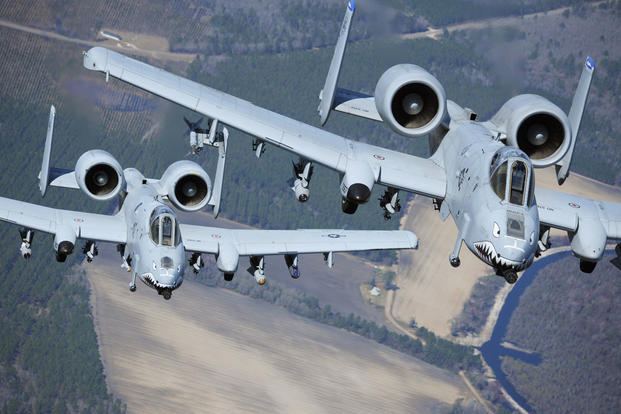The Air Force on Tuesday released a 2017 budget geared to rebalance the force and counter readiness problems resulting from years of deployments, personnel shortages and sequester-forced spending caps that have cut into modernization programs across the board.
At $167 billion, the service's budget is roughly $5 billion more than was appropriated for fiscal 2016, according to Air Force figures that show end strength will remain unchanged from the current year at 317,000 airmen.
Funding is designed to meet combatant commanders' needs in part by delaying the previously planned retirement of the A-10 Thunderbolt II now being used for operations in the Middle East. But officials are warning that the money is still not enough to retain a solid edge over adversaries who are "closing the gap in military capability," according to budget documents.
On the reserve side, end strength for the Air Force Reserve and the Air National Guard is basically unchanged for the fiscal year beginning Oct. 1. The Reserve would drop from 69,200 airmen to 69,000, while the air guard would actually increase by 200 airmen when it goes up to 105,700.
The Air Force continues to leverage the Guard and Reserve to meet mission, officials said.
"The Air Force continues to have significant readiness concerns," the budget documents state. "Though very good at current operations less than 50 percent of combat air forces are proficient in other required mission sets. Moreover, adversaries are closing the gap in military capability."
The Air Force reduced from 48 to 43 the number of F-35s it planned to buy next year and also put off modernization and recapitalizing programs in a number of areas, including delaying incremental replacement of its C-130H fleet.
"The [fiscal year] 2017 budget request represents a 'pivot point' for the Air Force to continue the recovery to balance the force for today's readiness and the readiness needed 10 to 20 years from now," the Pentagon said in its overview of the budget.
While the services did receive some relief from spending caps for 2016 when lawmakers raised the limits, the Pentagon suggests the move may "simply represent a pause to the devastating effects of sequestration level funding that will return in FY 2018."
The Air Force's 2017 budget for next year includes $5.2 billion for 43 F-35 Joint Strike Fighters; $2.2 billion toward the Long Range Strike Bomber (LRS-B), up from 2016's $1.5 billion; and $3.3 billion for the KC-46A tanker -- an increase of roughly $3 billion from 2016.
The next generation conventional and nuclear bomber remains one of the Air Force's priority acquisition programs.
Also critical to readiness is the KC-46A Pegasus tanker. Still under development, the KC-46A is to be capable of handling multi-point aerial refueling of U.S. and allied aircraft as well as handle aeromedical evacuation and cargo and passenger airlift.
The budget also includes $906 million next year for 24 MQ-9 Reaper drones. Of that amount $341 million is in the Air Force base budget and the balance from the Overseas Contingency Operations budget, a fund kept separate from the service's budget, exempt from spending caps and used for combat operations in Iraq, Afghanistan and elsewhere.
The RQ-4 Global Hawk is in line for $256 million for development and modification work next year but no purchases are planned, according to the Air Force budget. The budget includes no funds for the MQ-1 Predator, which last year was budgeted at $3.2 billion and is being phased out for the bigger Reaper.
Bryant Jordan can be reached at bryant.jordan@military.com. Follow him on Twitter at @bryantjordan.
Related Video:
Bullet Points: F35 Lightning II
Don't Miss a Single Military.com Story
To read the full article and get exclusive benefits, sign up today.
It’s FREE
Why am I seeing this? Visit our FAQs

























